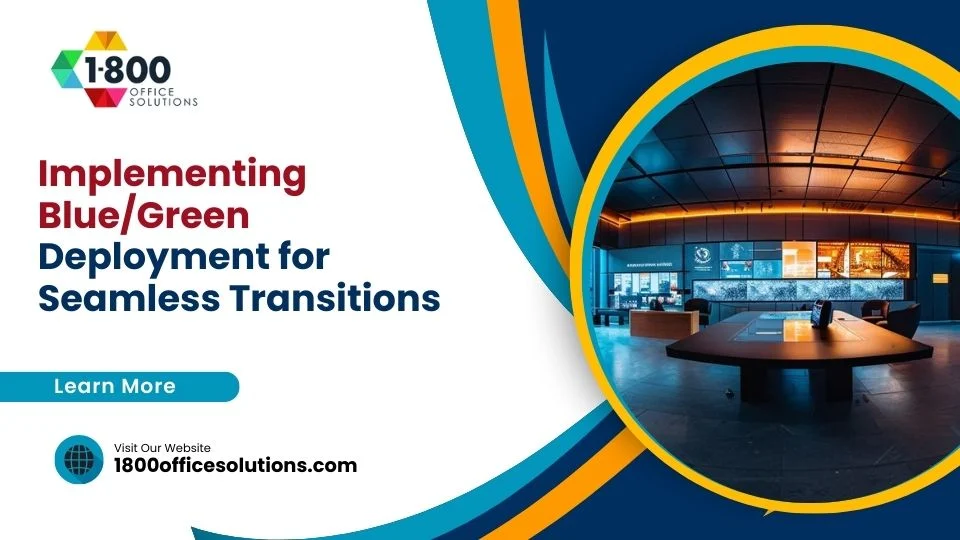The Comprehensive Overview of Enterprise IT Monitoring
AI Overview:
This blog provides a comprehensive guide to Enterprise IT Monitoring and its critical role in maintaining system performance, reliability, and efficiency. It explains how monitoring covers infrastructure, applications, networks, and resources to prevent downtime, optimize capacity, and support better decision-making. The article highlights key components such as infrastructure, application, and network monitoring, along with essential tools like APM solutions, log management systems, and AIOps. It also outlines best practices, including setting clear goals, integrating tools smoothly, and training teams effectively. Finally, it explores future trends such as AI, machine learning, and automated response systems, showing how unified monitoring solutions will continue to shape resilient, high-performing IT environments.

In an age where IT infrastructure is critical to business success, many organizations struggle with maintaining optimal application performance and effective service monitoring. This article offers a comprehensive overview of enterprise IT monitoring, including its key components, essential tools, and best practices for implementation. By understanding these elements, readers will learn how to enhance their IT monitoring strategies, addressing common challenges and ultimately improving their system reliability. For tailored solutions, do not hesitate to contact us as we explore the vital role of IT monitoring in streamlining operations.
What Is Enterprise IT Monitoring?
Enterprise IT monitoring involves tracking the performance and health of an organization’s IT infrastructure and services. This includes components such as servers, networks, applications, and storage devices, ensuring they operate efficiently and effectively. For more information, contact us.
One key aspect of enterprise IT monitoring is capacity planning. This involves analyzing current resource usage and predicting future needs, which helps organizations avoid performance issues and optimize resource allocation.
Synthetic monitoring is another technique used in enterprise IT monitoring. It simulates user interactions to evaluate system performance and identify potential issues before they affect end users, thereby enhancing the reliability of IT services.
Overall, effective IT monitoring not only improves operational efficiency but also aids in proactive decision-making regarding pricing and the management of hardware components, such as hard disk drives. This approach helps organizations maintain a resilient and responsive IT environment.
The Importance of Enterprise IT Monitoring
Enterprise IT monitoring plays a crucial role in enhancing operational efficiency by ensuring optimal productivity across systems. Effective monitoring minimizes downtime, fostering increased uptime and reliability. Additionally, it supports management efforts in resource allocation, particularly with data integration and kubernetes monitoring, ultimately leading to better utilization of IT resources.
Enhancing Operational Efficiency
Enhancing operational efficiency within an organization relies heavily on effective data collection and monitoring tools. By utilizing automated systems to gather insights on resource usage and system performance, businesses can identify bottlenecks and streamline processes. For example, integrating Microsoft Azure’s monitoring tools enables organizations to simplify the management of their IT infrastructure while improving overall efficiency through real-time performance tracking.
Moreover, automation plays a significant role in optimizing workflows and reducing manual errors. By deploying automated monitoring solutions, companies can ensure continuous oversight of their IT environment, allowing for quicker response times to potential issues. This proactive approach not only maximizes the efficiency of IT operations but also frees up valuable resources, enabling staff to focus on strategic initiatives rather than routine maintenance tasks.
Reducing Downtime and Ensuring Reliability
Reducing downtime and ensuring reliability are critical aspects of enterprise IT monitoring. By implementing robust monitoring solutions, organizations can identify potential resource failures early, allowing for quick intervention. For instance, proactive management of VMware environments and secure firewall configurations can significantly decrease the risk of system outages, leading to continuous workflow and operational stability.
Additionally, effective monitoring of IT infrastructure enables teams to establish reliable performance benchmarks. This insight allows companies to fine-tune their resource allocation and swiftly address any issues that may compromise system integrity. By maintaining an agile response to potential failures, organizations can safeguard their operations, ensuring minimal disruption and enhancing overall operational resilience.
Optimizing Resource Utilization
Optimizing resource utilization is crucial for maintaining a well-functioning IT ecosystem. Effective IT monitoring helps organizations track server performance and database health, enabling them to identify underused resources or potential bottlenecks. For instance, IT teams can apply patches and updates as needed, ensuring that all components of the infrastructure are operating efficiently and contributing to overall performance.
Moreover, implementing a systematic approach to resource management allows businesses to make informed decisions based on data insights. Organizations can benefit from developing white papers that outline their resource utilization strategies, reflecting on their monitoring practices and the impact of rigorous oversight on operational capabilities. This framework not only enhances productivity but also reduces unnecessary expenditures associated with resource mismanagement.
Key Components of Effective IT Monitoring
Effective enterprise IT monitoring relies on several key components. Infrastructure monitoring insights, utilizing tools like Nagios, provide essential data on system performance and memory usage. Application performance insights focus on optimizing software functionality, while network monitoring essentials evaluate connectivity and resource allocation within the virtualization landscape. Together, these elements enhance configuration management and overall operational stability.
Infrastructure Monitoring Insights
Infrastructure monitoring insights are pivotal for organizations to maintain oversight over their equipment and IT assets. By implementing observation tools that utilize telemetry data, businesses can monitor the performance and health of their systems in real-time. This proactive approach to service management enables teams to detect anomalies early, facilitating swift resolutions and ensuring system reliability.
Moreover, careful attention to access control within infrastructure monitoring enhances security measures across the IT landscape. Effective strategies for managing access permissions help organizations protect sensitive data and resources while optimizing performance. By analyzing telemetry and observation data, businesses can refine their monitoring approaches, ensuring that all equipment operates at peak efficiency and aligns with overall operational goals.
Application Performance Insights
Application performance insights are integral for organizations seeking to optimize user experience and ensure efficient operation of software applications. By utilizing open source monitoring tools, teams can gain real-time visibility into application performance metrics, enabling them to identify performance bottlenecks that may affect end users. For instance, integrating application performance monitoring solutions within a DevOps framework allows organizations to streamline their development and operational processes, ensuring that software updates do not compromise system stability.
Moreover, organizations that prioritize application performance insights can proactively address issues before they escalate into significant problems. This involves implementing automated monitoring systems that provide critical data on application response times and resource consumption. By analyzing this data, organizations can make informed decisions about resource allocation and application enhancements, ultimately improving the overall user experience and maintaining high standards of service reliability.
Network Monitoring Essentials
Network performance monitoring is essential for ensuring that an organization’s IT infrastructure operates smoothly and efficiently. By employing real-time data collection and analysis, IT teams can assess network behavior, detect anomalies, and prevent issues that may lead to data loss. For instance, implementing comprehensive monitoring tools allows organizations to identify performance bottlenecks quickly, enabling swift interventions that mitigate risks and maintain optimal network functionality.
Effective network monitoring also empowers organizations to gain valuable insights into traffic patterns and user behavior. This understanding can inform resource allocation strategies, ensuring that critical applications receive the bandwidth they require for peak performance. By prioritizing network performance monitoring, businesses can not only enhance overall operational efficiency but also reduce the likelihood of disruptions, thus fostering a reliable working environment for all stakeholders.
Tools and Technologies for Enterprise IT Monitoring

Effective enterprise IT monitoring relies on various tools and technologies that enhance visibility and performance. APM solutions provide in-depth application insights, while network monitoring software like PRTG Network Monitor ensures optimal network functionality. Infrastructure management tools and log management systems are crucial for maintaining system health and security. Additionally, AIOps enhancements improve scalability and usability, enabling organizations to proactively manage their IT environments.
APM Solutions
Application Performance Management (APM) solutions play a vital role in ensuring that applications operate efficiently within an enterprise’s IT infrastructure. Tools like New Relic and Prometheus offer comprehensive insights into application performance metrics, enabling organizations to identify and address vulnerabilities before they escalate. By integrating effective patch management strategies alongside these tools, businesses can enhance their application stability and security, leading to improved user experiences and reduced operational risks.
Furthermore, APM solutions are particularly beneficial in hybrid IT environments, where applications may span on-premises and cloud resources. These tools facilitate real-time monitoring and analytics, allowing IT teams to gain visibility into resource usage and performance across various platforms. As enterprises continue to adapt their infrastructure, leveraging APM solutions ensures that applications remain responsive and reliable, ultimately fostering a productive atmosphere for stakeholders.
Network Monitoring Software
Network monitoring software is essential for maintaining the health and efficiency of IT infrastructures. Tools like Splunk provide real-time insights into network performance and traffic, allowing IT teams to monitor devices such as routers effectively. By integrating Kubernetes deployment environments, businesses can automate the monitoring process, ensuring that resources are optimally utilized and performance issues are identified before they impact operations.
Furthermore, leveraging cloud services such as AWS can enhance network monitoring capabilities by providing scalable solutions that adapt to an organization’s changing needs. This approach allows teams to not only monitor current performance but also engage in proactive learning based on historical data trends. By adopting robust network monitoring software, organizations can ensure reliable connectivity and performance across their IT landscape, thereby reducing downtime and improving overall productivity.
Infrastructure Management Tools
Infrastructure management tools play a crucial role in maintaining the health and efficiency of data centers. By providing real-time monitoring and management capabilities, these tools enable organizations to proactively address issues that may arise within their IT infrastructure. This ensures that all systems operate optimally and remain compliant with necessary regulatory standards, safeguarding sensitive data and minimizing potential risks.
Moreover, managed services that integrate infrastructure management tools can enhance operational effectiveness by streamlining workflows and improving resource allocation. These solutions allow IT teams to gain valuable insights into system performance and make informed decisions that support organizational goals. As a result, businesses can achieve higher levels of reliability and compliance, empowering them to focus on strategic initiatives while the infrastructure is effectively managed.
Log Management Systems
Log management systems are essential for organizations looking to enhance their IT monitoring capabilities, particularly in relation to application performance management. These systems collect and analyze data from various applications and infrastructure components, enabling IT teams to identify performance issues and operational inefficiencies promptly. For instance, log management can provide insights into software development processes, helping teams optimize workflows by addressing bugs or delays quickly.
Incorporating log management systems is particularly beneficial when outsourcing IT functions or utilizing container technologies like Docker. By centralizing logs across different environments, businesses can maintain a clear overview of their systems, ensuring that any anomalies are detected and resolved efficiently. This proactive approach not only improves overall operational stability but also facilitates compliance with regulatory standards, safeguarding critical data and enhancing stakeholder trust.
AIOps Enhancements
AIOps enhancements significantly improve the effectiveness of enterprise IT monitoring by leveraging advanced data analytics and machine learning algorithms. These enhancements enable organizations to analyze vast amounts of monitoring metrics in real-time, resulting in quicker identification of anomalies and potential security breaches. By integrating comprehensive dashboards, IT teams gain instant visibility into the health of their systems, ensuring they can proactively address issues before they impact customer operations.
Best Practices for Implementing IT Monitoring
Establishing clear monitoring goals is essential for developing an effective monitoring system that aligns with organizational needs. Integrating monitoring tools seamlessly helps streamline processes, while training teams in log analysis ensures swift responses to issues. This subsection will discuss these best practices, providing actionable insights on optimizing enterprise IT monitoring and enhancing system performance.
Establishing Clear Monitoring Goals
Establishing clear monitoring goals is essential for an effective IT monitoring strategy, particularly within cloud infrastructure environments. By defining specific objectives, organizations can focus their monitoring systems on key performance indicators that directly impact costs and service delivery. For instance, integrating tools like ServiceNow can simplify goal-setting by enabling seamless tracking of system performance against established benchmarks, ensuring alignment with business objectives.
Furthermore, clear monitoring goals facilitate proactive identification of potential issues before they escalate. Organizations that prioritize these goals can ensure their systems remain resilient in the face of internet threats, optimizing both performance and resource utilization. For example, by monitoring usage patterns and response times, businesses can adjust resources dynamically, reducing costs and enhancing user satisfaction across their IT landscape.
Integrating Monitoring Tools Seamlessly
To achieve seamless integration of monitoring tools, companies must prioritize compatibility and interoperability across their IT landscape. This involves selecting solutions that align well with existing infrastructure, particularly in cloud computing environments, where latency can significantly impact performance metrics. By ensuring that monitoring tools function cohesively, organizations can maintain real-time visibility into system health and effectively manage resources across various platforms.
Effective cloud monitoring strategies hinge on establishing centralized dashboards that aggregate data from multiple sources, thus enabling quick assessment of overall system performance. This integration allows teams to identify performance issues promptly and allocate resources where necessary, ultimately enhancing system reliability. Prioritizing seamless integration not only streamlines operational processes but also empowers companies to make informed decisions that optimize their IT environments.
Training Teams for Effective Response
Training teams to respond effectively entails equipping them with knowledge and skills in advanced techniques like root cause analysis and application performance monitoring. When IT personnel understand how to leverage artificial intelligence-driven insights, they can swiftly identify and address issues, minimizing downtime associated with virtual machine failures. This understanding not only fosters a responsive environment but also enhances the overall health of the IT infrastructure.
Moreover, regular training sessions focused on the latest monitoring tools and methodologies can empower teams to engage in proactive measures, preventing problems before they disrupt operations. By incorporating real-world scenarios into training, organizations can better prepare their staff to handle unexpected challenges, ensuring that they are not only reactive but also capable of implementing strategies that support operational continuity across their systems.
Future Developments in IT Monitoring
The future of IT monitoring is poised for significant advancements, focusing on the role of artificial intelligence and machine learning. These technologies are set to enhance experience by enabling smarter change management and improving real user monitoring capabilities. Additionally, trends in automated response systems highlight the growing need for unified monitoring solutions, ensuring that organizations can effectively oversee diverse software environments.
The Role of AI and Machine Learning
The incorporation of artificial intelligence (AI) and machine learning into enterprise IT monitoring enhances security by enabling the identification of anomalies and potential threats in real-time. By analyzing data with tools like Elasticsearch, organizations can proactively detect irregularities in system behavior before they escalate into significant issues. This capability not only protects sensitive information but also contributes to improved customer satisfaction as services remain uninterrupted and reliable.
Machine learning algorithms can also optimize application monitoring by learning from historical data patterns and predicting performance metrics. This predictive analysis allows IT teams to address potential shortcomings proactively, ensuring systems run smoothly and efficiently. As organizations increasingly rely on automated responses driven by AI, the ability to maintain high operational standards will be crucial for fostering both performance and customer trust.
Trends in Automated Response Systems
The landscape of IT monitoring is shifting towards automated response systems that enhance visibility and streamline operational processes. By leveraging advanced technologies, organizations can now utilize monitoring software equipped with sophisticated analytics capabilities to identify and address issues in real-time. This proactive approach not only minimizes downtime but also allows teams to focus on critical tasks rather than routine problem-solving, ultimately improving overall efficiency.
Furthermore, the integration of data retention practices within these automated systems ensures that organizations maintain access to historical data for in-depth analysis. This capability enables IT teams to detect patterns and trends that inform better decision-making and resource allocation. By adopting these trends in automated response systems, businesses can foster a more resilient IT environment, capable of adapting quickly to evolving challenges and optimizing performance across their infrastructure.
Growing Need for Unified Monitoring Solutions
The growing need for unified monitoring solutions stems from the increasing complexity of IT environments, particularly with the rise of microservices and cloud-based architectures. Organizations striving for digital transformation must ensure that their various components, such as APIs and applications, work seamlessly together. This requires a centralized approach to IT service management that provides comprehensive visibility across all layers of the infrastructure, allowing teams to identify issues quickly and enhance operational efficiency.
Unified monitoring solutions not only streamline oversight but also facilitate proactive decision-making essential for maintaining reliability in digital services. By integrating various monitoring tools into a single platform, businesses can effectively manage their IT resources, making it easier to address potential performance bottlenecks before they impact end users. This approach aligns with the needs of organizations aiming to optimize their IT strategies while adapting to the demands of a rapidly evolving digital landscape.
Conclusion
Enterprise IT monitoring serves as a foundational element for maintaining operational efficiency and ensuring reliability within organizations. By implementing comprehensive monitoring strategies, businesses can proactively identify and address issues, optimize resource utilization, and minimize downtime. Key components such as infrastructure insights, application performance metrics, and network monitoring are essential for streamlining processes and enhancing productivity. Emphasizing these practices not only fortifies IT environments but also positions organizations for sustained success in an increasingly complex digital landscape.










